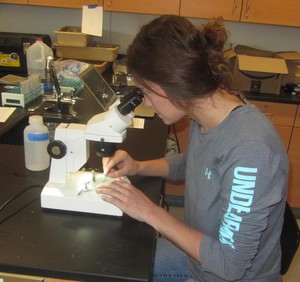Student's research could help manage invasive rangeland grass

CHADRON – A summer internship in North Dakota and hours of peering into a microscope in the Rangeland Complex’s lab have given Chadron State College junior Vanessa Yeoman an experience in primary research and may net her publication of an article in a scientific journal.
But there is a more important aim to the tedious work of microscopically examining hundreds of axillary buds of smooth brome grass and that is finding out how controlled grazing might help control the spread of an invasive plant that takes over rangeland and drives out native species, Yeoman said.
“Our main goal is to find a solution to help management of smooth brome,” Yeoman, a native of Hot Springs, South Dakota, said. “It is a highly aggressive, invasive perennial (grass). It has kind of taken over a lot of the Great Plains.”
Smooth brome (Bromus enermis) was introduced into the U.S. in the 1880s as a cool season forage grass for livestock, and remains popular for that purpose, as well as for erosion control, according to Aaron Field, assistant professor in the CSC rangeland program and Yeoman’s project adviser. However, its aggressive spread has led to huge monoculture patches in the Northern Great Plains, driving out native grasses and reducing plant and wildlife diversity, Field said.
“What I hope we will eventually find are practical ways to put it at a competitive disadvantage with our native species,” he said.
When Yeoman approached the rangeland faculty about conducting an undergraduate research project, smooth brome seemed to be a good choice, in part because Assistant Professor Tony Perlinski is already working on a control project for the grass.
“We thought it would be interesting to approach the same problem from a different angle,” Field said.
Yeoman found funding for the research project she designed from the Mari Sandoz High Plains Heritage Society and was able to secure a summer internship at the USDA Agricultural Research Service Great Plains Research Laboratory in Mandan, North Dakota, where she completed the first part of her work.
“We had to go to the field and mark (plant samples), then we would defoliate them to simulate grazing,” Yeoman said.
Plants were marked and clipped at different growth stages before being left to regrow through the summer. The samples were collected last month and brought to Chadron where Yeoman has spent several weeks examining the condition of the tiny buds on the plants’ underground stems where new growth takes place.
“We count them and then do a staining procedure that will tell us whether they are active, dormant or dead,” she said. “That will kind of tell us how defoliation affected reproduction.”
Examining each of the more than 200 samples takes from 15 to 30 minutes, meaning lots of microscope time for Yeoman. After analyzing the results, she plans to write a research paper she hopes to have published in a rangeland or conservation-related scientific journal.
Yeoman will also present her work at the International Meeting of the Society for Range Management, and other venues, Field said.
Although results of the research aren’t complete, Yeoman said she suspects that the timing of cutting or grazing the grass may be critical in slowing or stopping it from reproducing.
“Cutting in different stages will make it grow more, or stop it from growing,” she said.
Getting an article published while still an undergraduate would be a definite plus for Yeoman’s resume, especially if she elects to go to graduate school, but the project will help her in other ways too, Field said.
“I think the real benefit has been the people she has met and the skills she has gained,” he said. “Those contacts will serve her well whether she continues her education in science or moves in a different direction.”
Though not from a ranching background, Yeoman said she would like to own a ranch someday.
“I’m interested in how grazing affects plant communities and using grazing to manipulate plant growth,” she said.
Category: Campus News, Range Management



